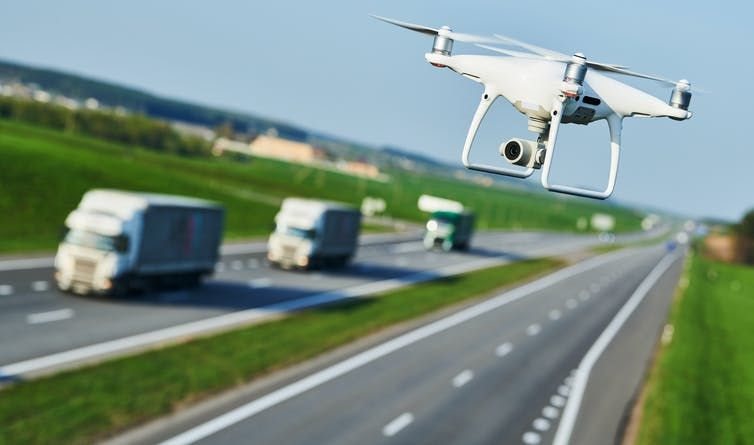Make drones sound less annoying by factoring in humans at the design stage
One Nasa study found that drone sounds were more annoying than those made by road vehicles. And my own research has found that the noise of drones is less preferable than that of civil aircraft – even at the same volume.
Part of the problem is that drones often fly at relatively low altitudes over populated areas that are not normally exposed to aircraft noise. This is likely to lead to tensions within the exposed communities. Unquestionably, if the noise issues are not tackled appropriately, they could derail the wider adoption and commercialisation of drones and put at risk the significant societal benefits that they could bring.
For example, small to medium size drones are already used for multiple applications such as medical deliveries and the search for missing persons. Another innovation in commercial aviation is the development of electrical vertical takeoff and landing (and possibly autonomous) vehicles to transport people in cities.
Several "urban air mobility" vehicles, or "flying taxis" are currently being developed by different aircraft manufacturers. Both drones and flying taxis will produce sounds significantly different from conventional civil aircraft and will share similar issues regarding noise annoyance.
In 2019, I started a line of research which aimed to answer two big questions: how will communities react to these new vehicles with unconventional noise signatures when they begin to operate at scale? And how can the design of these new vehicles be improved to protect the health and the quality of life of the people living in those communities?
To answer the first question, we investigated how a drone operation could influence the perception of a series of typical sound environments in cities. As drones cannot be flown closer to people than 50m, virtual reality techniques were used to produce highly realistic scenarios with a drone hovering in a selection of urban locations.
This laboratory study found that the noise generated by the hovering of a small quad-copter significantly affected the perception of the sound environment. For instance, an important increase in noise annoyance was reported with the drone hovering, particularly in locations with low volumes of road traffic. This suggested that the noise produce by road traffic could make drone noise less noticeable. So the operation of drones along busy roads might mitigate the increase of noise impact caused in the community.
Bonython: A world first drone delivery trial is dividing residents on the outskirts of Canberra. Some are so fed up with the noise they're now spending their weekends away. A taste of what's to come as the program spreads. @jenbechwati #Bonython #Drones #7News pic.twitter.com/ryRUStaFv7
— 7NEWS Sydney (@7NewsSydney) January 3, 2019
Perception-influenced engineering
By integrating human responses into the design process, the most undesirable noises can be avoided in the earliest stages of vehicle development.
This can either be done directly with subjective testing (human participants assessing and providing feedback for a series of drone noise samples) or through the use of so-called psycho-acoustic metrics which are widely adopted in the automotive industry. These metrics allow an accurate representation of how different sound features (pitch, temporal variations, tones) are perceived. We want to use them to inform the design of drones. For instance, optimising the position of rotors to make drones sound less annoying.
The combination of virtual reality techniques and psycho-acoustic methods to inform the design and operation of drones will avoid costly and inefficient ad-hoc corrections at later stages, going beyond the traditional approach for aircraft noise assessment. But more importantly, if drone manufacturers incorporate these strategies into their designs, they might just build machines that are not only efficient, but also, just that little bit less irritating.
This article is republished from The Conversation under a Creative Commons license. Read the original article.
Source: The Conversation Africa

The Conversation Africa is an independent source of news and views from the academic and research community. Its aim is to promote better understanding of current affairs and complex issues, and allow for a better quality of public discourse and conversation.
Go to: https://theconversation.com/africa




